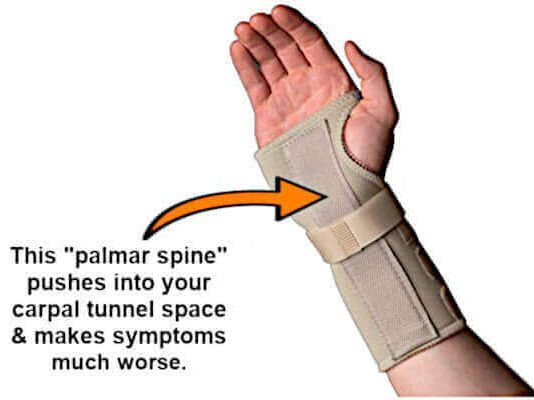How Carpal Tunnel Happens
Table of Contents
- Overview
- What Causes Carpal Tunnel Syndrome?
- Who Gets Carpal Tunnel Syndrome?
- What are the Symptoms of Carpal Tunnel Syndrome?
- When Carpal Tunnel Syndrome Begins
- When Carpal Tunnel Syndrome
- How is Carpal Tunnel Syndrome Diagnosed?
- What Are the Best Treatments for Carpal Tunnel Syndrome?
Summary
FAQs
About
Overview
There can be many reasons we get carpal tunnel syndrome. Hands that are repetitively stressed is a common one. But sometimes, there is no apparent reason for getting this disorder.
Whatever the reason for its occurrence, exactly how carpal tunnel happens inside your body is the same. It begins when the
median nerve (a main nerve running from your arm and into your hand) gets compressed. The compression happens inside the carpal tunnel passageway deep inside the wrist joint.
This tight, narrow passageway is bordered by wrist bones and a thick ligament. It contains the median nerve, as well as your flexor tendons (responsible for curling your fingers). If pressure increases from the tendons or other tissues around the median nerve, compression of the nerve results.
This compression is what causes all of the symptoms of carpal tunnel syndrome. Symptoms like pain, numbness, tingling, and burning occur mainly in the palm, thumb, and fingers (but not the little finger).
What Causes Carpal Tunnel Syndrome?
In some patients, the cause of carpal tunnel syndrome is unknown. But the vast majority of patients can trace the cause to one or a combination of factors that can alter the structure of their wrist area. These include:
- Injury or trauma (like a fracture or sprain) to your wrist area, resulting in swelling.
- Health conditions which can affect various parts of your body, including your nerves, such as:
- Rheumatoid arthritis
- Diabetes
- A cyst in your wrist
- Hormonal change which can result in fluid retention and swelling (e.g.,
pregnancy, menopause, hypothyroidism).
- Your wrist anatomy (narrow wrists are more susceptible).
- Performing
harmful hand activities such as:
- Rapid and repetitive movements (gaming, assembly line work, carpentry, knitting,
typing)
- Prolonged grip-and-release (golf, gardening, grocery handling)
- Prolonged pinching (knitting, writing,
graphic arts, electronic assembly)
- Extreme wrist bending (furniture moving, auto mechanics, warehousing, waste removal)
- Tight gripping (golf, construction work, flooring,
hair styling, cleaning)
- Using
vibrating tools (carpentry, woodworking, masonry, landscaping)
These harmful activities definitely exert unusual forces and strain on your hand. But the current controversy is whether or not any of these harmful activities actually “cause” carpal tunnel syndrome.
Who Gets Carpal Tunnel Syndrome?
Carpal tunnel syndrome can happen to anybody, and at any age. However, it is rare for it to occur in mid teenage years. The following risk factors have been established. That means they have a higher likelihood of resulting in developing carpal tunnel syndrome.
- Being female: Females are
several times more likely to have carpal tunnel syndrome than males.
- Being pregnant: Pregnancy increases your risk several-fold. About 50% of women see symptoms resolve after childbirth.
- Having rheumatoid arthritis: Not only does RA increase your probability, but the symptoms can be similar, particularly pain.
- Have a health condition affecting your wrist: The most common are gout and osteoarthritis.
- Engage in harmful hand activities: Your occupation or hobby may be a major contributor to stressed hands.
- Had a recent wrist injury: It is common to see carpal tunnel symptoms within weeks or months of a wrist fracture.
- Genetics: If you have a
parent or sibling, you chance of getting it increases greatly.
What are the Symptoms of Carpal Tunnel Syndrome?
Symptoms can vary from one person to another. But most people have certain symptoms in common. These symptoms are located in your palm and fingers. Usually the thumb, index, and middle fingers are most involved. About 88% of the time, symptoms affect
both hands. They include:
When Carpal Tunnel Syndrome Begins
When carpal tunnel syndrome first begins (the Mild stage) symptoms usually:
- Start gradually: You may feel like you strained or overworked your hand.
- Occur while sleeping: Most of the time, you notice having to
wake up to shake out your hand.
As Carpal Tunnel Syndrome Advances
When carpal tunnel syndrome advances, symptoms worsen. Sometimes brand new symptoms appear. These include:
- Weakness: You have noticeable loss of grip strength, and it becomes difficult to grasp or hold small things.
- Puffy feeling: This feels like your fingers are swollen, but they look normal.
- Clumsiness: You fumble with small objects like coins, or you start dropping things.
- Temperature insensitivity: It becomes more difficult to feel hot water on your fingers.
If you ignore the problem, you risk permanent weakness and loss of feeling. This is why early diagnosis and treatment is important.
How is Carpal Tunnel Syndrome Diagnosed?
There are two ways you can have a carpal tunnel diagnosis.
- You can visit your doctor. The doctor will review your history and perform a physical exam. If warranted, the doctor will order lab tests to rule out other
nerve damaging disorders, take X-rays to rule out arthritis or a fracture, and order an
EMG to test you nerves.
- You can also test yourself. You can perform the same physical tests you doctor performs in your own home. These are called provocative tests,
and you can learn them here. Once you confirm you have carpal tunnel syndrome, you can test how severe it is
with this Quiz. The Quiz is a
highly accurate predictor of your severity.
What Are the Best Treatments for Carpal Tunnel Syndrome?
The key to successful treatment of carpal tunnel syndrome is to begin early. The longer you allow symptoms to take hold, the more difficult it will be to see good results.
Depending on
how severe your carpal tunnel syndrome, one or more of the following conservative treatments can provide good results.
- Avoidance: Avoid or stop the activity that strained you hand.
- Over-the-counter pain relievers: These include ibuprofen, aspirin, and naproxen sodium.
- Night bracing: Keeping you hand in the neutral position while you sleep is helpful.
Be sure to wear an appropriate night brace.
- Stretching exercises: There are
4 core stretching exercises that should be performed every 1-2 hours.
- Myofascial wrist massage: This is an exceptionally powerful tool to fight this disorder.
Learn more here.
- Steroid injections: Your doctor injects a
corticosteroid into your wrist to reduce inflammation.
- Hydrodissection: Performed under ultrasound, a needle separates and frees your median nerve from surrounding tissues.
If the above remedies are not successful, then you may require surgery.
Carpal tunnel release surgery aims to cut a ligament inside your wrist in order to separate your wrist bones. Doing so creates more space inside the carpal tunnel. This in turn “releases” pressure on your median nerve.
If the above remedies are not successful, then you may require surgery.
Carpal tunnel release surgery aims to cut a ligament inside your wrist in order to separate your wrist bones. Doing so creates more space inside the carpal tunnel. This in turn “releases” pressure on your median nerve.
There are two basic types of carpal tunnel release surgery. Both have significant
pros and cons.
- Open release surgery: This surgery creates a 2-3 inch long incision on your palm. Pain is more prolonged, aftercare is more involved, and healing time is longer. But this is considered the "safer" option.
- Endoscopic release surgery: This surgery requires one or two half-inch holes in your palm. Post surgical pain is less, aftercare is easier, and healing time is shorter. This is considered the "less safe" option.
The success rate of carpal tunnel release surgery (whichever option you choose) is
about 50%. This means about half of patients are dissatisfied with their outcome two years later. The primary reason for dissatisfaction is
return of symptoms.
Summary
Carpal tunnel syndrome occurs when there is extra pressure on the median nerve inside your wrist joint. The most common symptoms include pain, numbness, tingling, burning or weakness. These occur in your thumb, index, and middle fingers, as well as the palm of your hand. Your doctor can use tests to diagnose carpal tunnel syndrome. Additional tests can rule out other causes of wrist and hand pain. You can perform some of the same tests at home, which are accurate and reliable. Carpal tunnel treatments will vary according to your severity. They include night bracing, stretching exercises, and myofascial wrist massage. More aggressive therapies include steroid injections and hydrodissection. If these fail, then carpal tunnel release surgery may be required.
FAQs
- How does carpal tunnel syndrome happen?
It happens when the median nerve inside your wrist joint gets compressed by the tissues surrounding it.
- What causes carpal tunnel syndrome?
While there is no direct "cause" of the disorder, many risk factors can contribute to getting it. These risk factors range from performing harmful hand activities to having fluid imbalances inside your wrist.
- What are the symptoms of carpal tunnel syndrome?
Symptoms may include tingling, pain, numbness or weakness in the thumb and middle fingers, as well as the palm of the hand.
Females are more likely to get carpal tunnel syndrome.
- How is carpal tunnel syndrome diagnosed?
One of the most sensitive tests for carpal tunnel syndrome are called provocative tests. Your doctor can perform them, or you can do them at home.
- How is carpal tunnel syndrome treated?
It is usually treated according to severity. Treatments include night bracing, stretching exercises, and myofascial wrist massage. More aggressive treatments include steroid injections, hydrodissection, and surgery.
About








